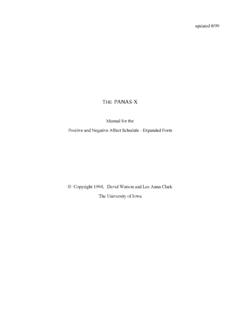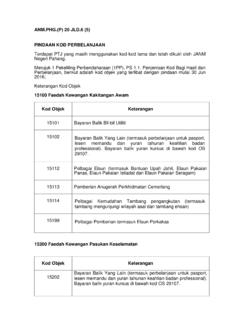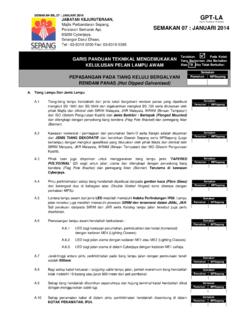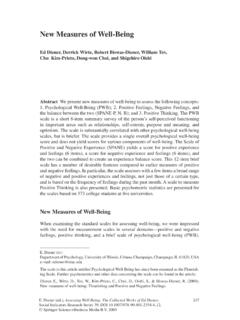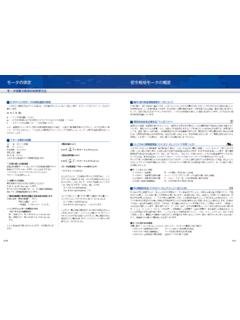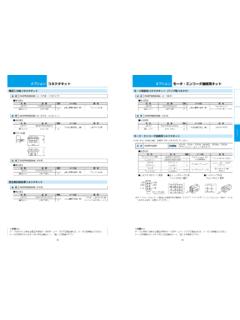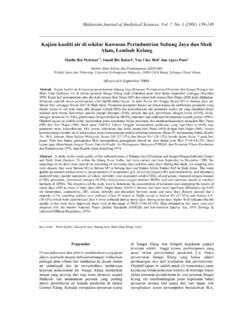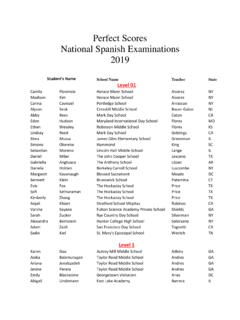Transcription of Development and Validation of Brief Measures of Positive ...
1 Journal of Personality and Social Psychology1988. Vol. 54. No. 6, 1063-1070 Copyright 1988 by the American Psychological Association, $ and Validation of Brief Measures of Positiveand negative affect : The PANAS ScalesDavid Watson and Lee Anna ClarkSouthern Methodist UniversityAuke TellegenUniversity of MinnesotaIn recent studies of the structure of affect , Positive and negative affect have consistently emerged astwo dominant and relatively independent dimensions. A number of mood scales have been createdto measure these factors; however, many existing Measures are inadequate, showing low reliabilityor poor convergent or discriminant validity. To fill the need for reliable and valid Positive affect andNegative affect scales that are also Brief and easy to administer, we developed two 10-item moodscales that comprise the Positive and negative affect Schedule (PANAS).
2 The scales are shown to behighly internally consistent, largely uncorrelated, and stable at appropriate levels over a 2-monthtime period. Normative data and factorial and external evidence of convergent and discriminantvalidity for the scales are also dominant dimensions consistently emerge in studies ofaffective structure, both in the United States and in a numberof other cultures. They appear as the first two factors in factoranalyses of self-rated mood and as the first two dimensions inmultidimensional scalings of facial expressions or mood terms(Diener, Larsen, Levine, & Emmons, 1985; Russell, 1980,1983; Stone, 1981; Watson, Clark, & Tellegen, 1984; Zevon &Tellegen, 1982).Watson and Tellegen (1985) have summarized the relevantevidence and presented a basic, consensual two-factor some investigators work with the unrotated dimen-sions (typically labeled pleasantness-unpleasantness andarousal), the varimax-rotated factors usually called PositiveAffect and negative affect have been used more extensively inthe self-report mood literature.
3 They are the focus of this the terms Positive affect and negative affect mightsuggest that these two mood factors are opposites (that is,strongly negatively correlated), they have in fact emerged ashighly distinctive dimensions that can be meaningfully repre-sented as orthogonal dimensions in factor analytic studies , Positive affect (PA) reflects the extent to which a per-son feels enthusiastic, active, and alert. High PA is a state ofhigh energy, full concentration, and pleasurable engagement,whereas low PA is characterized by sadness and lethargy. In con-trast, negative affect (NA) is a general dimension of subjectivedistress and unpleasurable engagement that subsumes a varietyof aversive mood states, including anger, contempt, disgust,guilt, fear, and nervousness, with low NA being a state of calm-We wish to thank Lisa Binz, Sondra Brumbelow, Richard Cole, MaryDieffenwierth, Robert Folger, Jay Leeka, Curt Mclntyre, James Pen-nebaker, and Karen Schneider for their help in collecting the data re-ported in this should be addressed to David Watson, Departmentof Psychology, Southern Methodist University, Dallas, Texas, and serenity.
4 These two factors represent affective state di-mensions, but Tellegen (1985; see also Watson & Clark, 1984)has demonstrated that they are related to corresponding affec-tive trait dimensions of Positive and negative emotionality (indi-vidual differences in Positive and negative emotional reactivity).Trait PA and NA roughly correspond to the dominant personal-ity factors of extraversion and anxiety/neuroticism, respectively(Tellegen, 1985; Watson & Clark, 1984). Drawing on these andother findings, Tellegen has linked trait NA and PA, respectively,to psychobiological and psychodynamic constructs of sensitiv-ity to signals of reward and punishment. He has also suggestedthat low PA and high NA (both state and trait) are major distin-guishing features of depression and anxiety, respectively (Tel-legen, 1985; see also Hall, 1977).
5 Numerous PA and NA scales have been developed and stud-ied in a variety of research areas. Generally speaking, the find-ings from these studies indicate that the two mood factors relateto different classes of variables. NA but not PA is related toself-reported stress and (poor) coping (Clark & Watson, 1986;Kanner, Coyne, Schaefer, & Lazarus, 1981; Wills, 1986), healthcomplaints (Beiser, 1974;Bradburn, 1969; Tessler & Mechanic,1978; Watson & Pennebaker, in press), and frequency of un-pleasant events (Stone, 1981; Warr, Barter, & Brownbridge,1983). In contrast, PA but not NA is related to social activ-ity and satisfaction and to the frequency of pleasant events(Beiser, 1974; Bradburn, 1969; Clark & Watson, 1986, 1988;Watson, 1988).Anomalous and inconsistent findings have also been re-ported, however.
6 For example, whereas most studies have foundthese NA and PA scales to have low or nonsignificant corre-lations with one another ( , Clark & Watson, 1986, 1988;Harding, 1982; Moriwaki, 1974; Warr, 1978; Wills, 1986), oth-ers have found them to be substantially related (Brenner, 1975;Diener & Emmons, 1984; Kammann, Christie, Irwin, &Dixon, 1979). There are many possible explanations for suchinconsistencies ( , see Diener & Emmons, 1984), but one thatmust be considered concerns the various scales themselves. It10631064D. WATSON, L. CLARK, AND A. TELLEOENmay be, for example, that some scales are simply better, purermeasures of the underlying factors than are others. Watson (inpress) reported evidence supporting this idea. He found thatsome scale pairs (such as those used by Diener and his associatesin a number of studies; , Diener & Emmons, 1984; Diener &Iran-Nejad, 1986; Diener et al.)
7 , 1985) yield consistently higherNA-PA correlations than do others (such as our own scales, tobe described shortly).More generally, one must question the reliability and validityof many of these Measures . Some mood scales have been devel-oped through factor analysis ( , Stone, 1981), but others havebeen constructed on a purely ad hoc basis with no supportingreliability or validity data ( , McAdams & Constantian,1983). Watson (in press) analyzed the psychometric propertiesof several popular Measures and found many of them to bewanting, at least for use in student populations. For example,Bradburn's (1969) widely used NA and PA scales were unreli-able (coefficient a = .52 for NA, .54 for PA) and only moder-ately related to other Measures of the same factor (for NA, theconvergent correlations ranged from.
8 39 to .52; for PA, theyranged from .41 to .53). The short PA and NA scales used byStone and his colleagues (Hedges, Jandorf, & Stone, 1985;Stone, 1987; Stone, Hedges, Neale, & Satin, 1985) were alsounreliable (in two samples, the NA scale had coefficient as and .52, whereas the PA scale had corresponding values and .70).Clearly there is a need for reliable and valid PA and NA scalesthat are also Brief and easy to administer. In this article we de-scribe the Development of such scales, the 10-item NA and PAscales that comprise the Positive and negative affect Schedule(PANAS), and present reliability and validity evidence to sup-port their of the PANAS ScalesMuch of our previous mood research has been concernedwith identifying these dominant dimensions of affect and clari-fying their nature (Clark & Watson, 1986,1988;Tellegen, 1985;Watson, in press; Watson & Clark, 1984; Watson et al.
9 , 1984;Watson & Tellegen, 1985; Zevon & Tellegen, 1982). To have abroad and representative sample of mood descriptors, we haveused questionnaires that contained a large number (57-65) ofmood terms. Once the basic NA and PA factors were clearlyidentified, however, we wanted to measure them more simplyand economically. We therefore turned our attention to the de-velopment of Brief PA and NA greatest concern was to select terms that were relativelypure markers of either PA or NA; that is, terms that had a sub-stantial loading on one factor but a near-zero loading on theother. As a starting point, we used the 60 terms included in thefactor analyses reported by Zevon and Tellegen (1982). Thissample of descriptors was constructed by selecting three termsfrom each of 20 content categories; for example, the termsguilty, ashamed, and blameworthy comprise the guilty category(see Zevon & Tellegen, 1982, Table 1).
10 The categories were iden-tified through a principal-components analysis of content sort-ings of a large sample of descriptors and provide a comprehen-sive sample of the affective this list we selected those terms that had an averageloading of .40 or greater on the relevant factor across both theR- and P-analyses reported in Zevon & Tellegen (1982). TwentyPA markers and 30 NA markers met this initial criterion. How-ever, as noted previously, we were also concerned that the termsnot have strong secondary loadings on the other factor. Wetherefore specified that a term could not have a secondary load-ing of |.25| or greater in either analysis. This reduced the poolof candidate descriptors to 12 for PA and 25 for reliability analyses convinced us that 10 termswere sufficient for the PANAS PA scale; we therefore dropped 2terms (delightedand healthy) that had relatively high secondaryloadings on NA.
